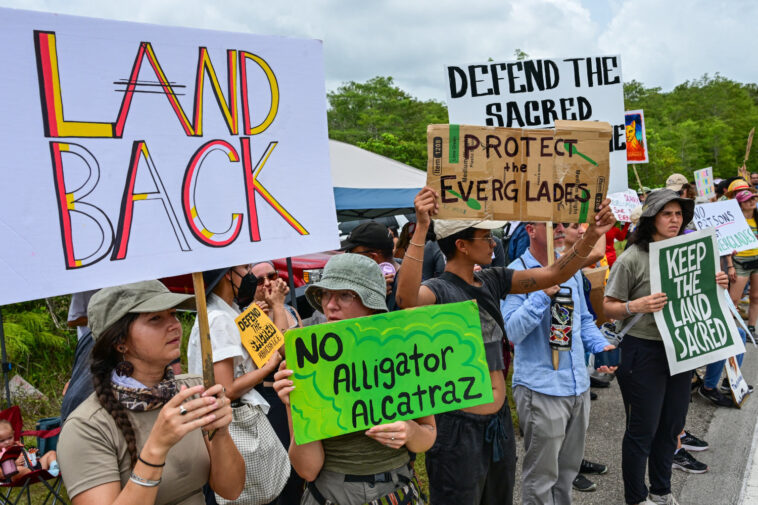This past weekend, the continuous flow of dump trucks and semi-trailers bustling into a site colloquially known as ‘Alligator Alcatraz’ provoked hundreds of sign-carrying demonstrators to voice their opposition on U.S. Route 41, adjacent to the Big Cypress National Preserve’s lands. Many passing vehicles honked in solidarity as the protesters hoisted placards, entreating for the safeguarding of the vast preserve, a refuge for dwindling animal species and home to several Native tribes.
This demonstration, coming on the heels of another significant protest the weekend before, saw active participation from influential figures like Betty Osceola, a notable Miccosukee leader and environmental educator residing near the site under contention. The Big Cypress Preserve hosts 15 traditional Miccosukee and Seminole tribal settlements, with various sacred and burial sites spread across its length and breadth.
Osceola expressed deep trepidation about the adverse effects of the camp on the local ecology and cultural heritage. She harbors a significant fear that the establishment of this facility could potentially pave the way for developers to encroach on this environmentally sensitive zone with residential and commercial projects. In hopes of halting this development, Osceola and her associates have appealed to higher powers through prayer.
The protest’s demographic was not limited to Native Americans. A diverse range of hundreds of individuals came forward to express their disdain for the camp and the proposed environmental degradation it represents.
In the meantime, Florida’s authorities have been persistently pushing forward with the construction of ‘Alligator Alcatraz’, amidst the humid swamps of the Everglades. The compound is meant to include temporary dwellings such as hard-wearing tents and trailers to accommodate detained immigrants.
The state government anticipates that by early July, the facility will have an operational capacity to provide detention accommodations for 5,000 immigrants. Advocates for the venture argue that situating the detention center in the midst of Florida’s reptile-laden wetlands, rife with creatures such as alligators and exotic invaders like Burmese pythons, makes it an ideally secured location for detaining immigrants.
In recent times, under the foreign policy influence of Governor Ron DeSantis, Florida has adopted a stringent stance towards enforcing immigration regulations. This has been in parallel with the broader crackdown on illegal immigration spearheaded by the federal government.
In a significant move, the U.S. Department of Homeland Security has offered its endorsement of ‘Alligator Alcatraz.’ DHS Secretary Kristi Noem has publicized that the funding for the project will be partly sourced from the Federal Emergency Management Agency.
Opposition to the project has taken the shape of legal action as well, as some environmental advocacy groups have initiated a federal lawsuit with a view to stopping the construction of the detention center. The plaintiffs include Friends of the Everglades and the Center for Biological Diversity, who have named the U.S. Department of Homeland Security, U.S. Immigration and Customs Enforcement, the Florida Division of Emergency Management, and Miami-Dade County as the defendants.
The lawsuit asserts the necessity for the suspension of the scheme until it successfully passes comprehensive environmental review norms in accordance with federal mandates. As per the lawsuit submitted in Miami federal court, there should also be sufficient opportunity for the public to present their comments and views.
Adding to the litigious resistance, Friday also saw the filing of an additional lawsuit related to the contested camp. The effort was led by a resident of Homestead, Joshua-Michael Van Schaick, and was targeted towards key figures such as DeSantis, Florida Attorney General James Uthmeier, the Florida Department of Management Services, U.S. Department of Homeland Security, and ICE. The primary objective of this lawsuit is to discourage further development of the detention camp at the specified location.

